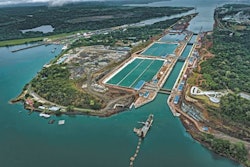
2016 sparked a long-term shift in the way we transport goods. Silicon Valley behemoths penetrated the commercial freight market. Big-time shippers overhauled distribution networks to capture a share of the growing e-commerce pie and cater to lofty consumer expectations. Technology advancements drove unprecedented innovation by logistics providers and shippers alike.
It’s been a dizzying year for supply chain and logistics managers, and that’s likely to remain the case in 2017. While we may not be primed just yet for autonomous trucks to take over the roads, we’re also not as far off as some might think. We know one thing for sure: Technology will continue to push the envelope industrywide, and all players will be forced to adapt or be left behind.
Here are four trends every stakeholder in the supply chain should watch closely in 2017:
1. Growth of the Tech-Enabled Logistics Provider
Technology permeates every area of the supply chain. Tracking solutions, sensors and other devices embedded in cargo and vehicles provide a real-time picture of assets (of all types, not simply trucks) in the field. On the backend, transportation management systems (TMSs) are becoming increasingly sophisticated, providing comprehensive transportation management from end to end.
Shippers and carriers will continue to lean on providers in 2017 as the tech leaders. Both parties, along with receivers, will look to smart logistics providers to tie seamless TMSs together with onboard tracking platforms and inventory management. The goal is optimized supply chains connecting in transit based on a real-time inventory snapshot.
2. Constricting Freight Market?
For much of the past year or so, shippers enjoyed favorable rates thanks to relatively highly available capacity. As a result, those who honed in on spot rates may have seen short-term cost savings, while those who focused on strategic carrier relationships traded potentially higher rates for long-term mutual benefits.
Recent reports indicate the pendulum may swing back in favor of the strategic approach, as capacity tightened modestly over the past few months. Several factors will influence whether this is a long-term or seasonal shift. Shippers and their logistics providers should keep a close eye on potential spikes in fuel cost, and pending hours of service and driver wage regulation, which will impact capacity in the coming years. In the case of market constriction, those with locked-in, long-term carrier relationships will reap the benefits—greater access to consistent and reliable capacity, more stable rates, and the ease and efficiency which come with familiarity.
3. Mastering E-Commerce Logistics
Online purchases continue to account for an increasingly large portion of overall retail sales. In fact, the U.S. recently experienced the highest e-commerce penetration in history, according to the U.S. Department of Commerce. This completely reset consumer expectations and, in turn, retailers’ delivery policies. Next-day and even same-day delivery are fast becoming the norm and retailers now have more stringent delivery deadlines (not to mention fees for late deliveries).
The e-commerce pie only continues to grow and retailers will continue to grapple for their share. We’ll likely see retailers establish a continuously broad network of distribution and fulfillment facilities near dense population centers. Enhanced business intelligence and in-vehicle technology will also be key, as retailers and their logistics providers seek ways to trim the e-commerce-related factors that historically drive costs higher, like high fuel consumption and inefficient routing.
Many retailers already established e-commerce delivery networks. Conquering the art of cost containment will be the next step.
4. Digital Freight Matching versus Driverless Trucks
Uber’s acquisition of self-driving trucking platform Otto sent a message to supply chain stakeholders: Silicon Valley has commercial transportation and logistics in the crosshairs. Reaction varied, and many set their sights on the potential for driverless or co-piloted trucks. But it’s another aspect of the deal—Uber’s long-term goal to establish a national digital freight matching (DFM) network—that may be more intriguing in the short term for logistics providers.
The two don’t necessarily fall hand in hand. Though driverless trucks may have more curb appeal, DFM apps could change the way shippers connect with carriers (and how logistics providers do business). In their current form, DFM apps could work for smaller-scale shippers, but not those with a large, regional and national footprint. More importantly, DFM apps will drive the industry at large (including third-party logistics or 3PLs) to innovate and develop more advanced TMSs, as well as challenge providers to diversify services.
Technology advances will continue to drive seismic shifts in the logistics industry in 2017 and we’ve only scratched the surface for what that could look like. Each stakeholder within the supply chain will address these areas in different ways, but ultimately, with the same goals: To provide higher quality customer service and more efficient, secure transportation.

















